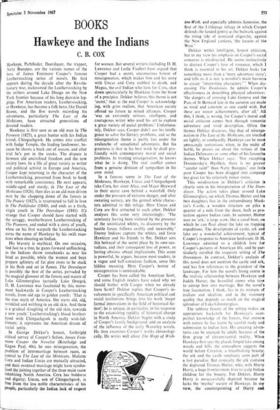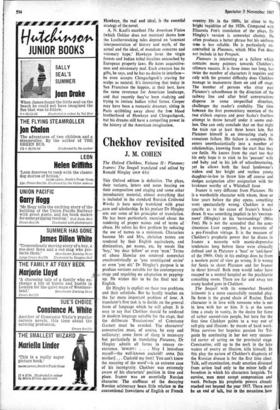Hawkeye and the Indians BOOKS
C. B. COX
Hawkeye, Pathfinder, Deerslayer, the trapper, Natty Bumppo, are the various names of the hero of James Fenimore Cooper's famous Leatherstocking series of novels. Ile first appears during the decade after the Revolu- tionary war, nicknamed the Leatherstocking by the settlers around Lake Otsego on the New York frontier because of his long deerskin leg- gings. For American readers, Leatherstocking, or Hawkeye, has become a folk hero, like Daniel Boone, and the five novels ,recording his adventures, particularly The Last of the Mohicans, have attracted generations of devoted readers.
Hawkeye is first seen as an old man in Vie Pioneers (1823), a great hunter with his Indian friend, Chingachgook. He comes into conflict with Judge Temple, the leading landowner, be- cause he shoots a buck out of season, and after trial he's put in the stocks. The dispute is between old uncivilised freedom and the new society laws. In a life of great variety as writer and political activist in Europe and America, Cooper kept returning to the character of the Leatherstocking, presented from book to book with remarkable consistency. He next appears; middle-aged and sturdy, in The Last of the Mohicans (1826), then dies as an old man driven west by the chopping down of the forests in The Prairie (1827), is resurrected to fall in love in The Pathfinder (1840), and ends as a fresh, virgin youth in The Deerslayer (1841). It's strange that Cooper should have started with the scraggy, weatherbeaten Leatherstocking of The Pioneers, and ended with a story of youth, when on his first warpath the Leatherstocking earns the name of Hawkeye by his swift reac- tions when shooting an Indian.
His bravery is mythical. On one occasions tied fast to a tree, he gazes forward unflinching, as the Indians throw tomahawks as near his head as possible, while the women and boys prepare splinters of fat pine roots to be stuck in his flesh and set in flames. The Deerslayer is possibly the best of the series, pervaded by the magical glamour of the forests and waters of Lake Glimmerglass (actually Lake Otsego), D. H. Lawrence was fascinated by this move- ment backwards in Cooper's Leatherstocking novels, from old age to golden youth: 'That is the true myth of America. She starts old, o.I4, wrinkled and writhing in an old skin. And there is a gradual sloughing of the old skin, towards a new youth.' Leatherstocking's blood brother- hood with Chingachgook is really wish-ful- filment; it represents the American dream of racial unity.
In George Dekker's honest, forthright critical survey of Cooper's fiction, James Feni- more Cooper the Novelist (Routledge and Kegan Paul, 40s), he sees miscegenation, the problem of intermarriage between races, as central to The Last of the Mohicans. Mulatto Cora and Indian Uncas are mutually attracted, and their eventual marriage might have symbo- lised the joining together of the three main races inhabiting North America. Cora has boldness and dignity; Uncas, son of Chingachgook, is free from the less noble characteristics of his People, particularly the Indian lack of respect for women. But several writers (including D. H. Lawrence and Leslie Fiedler) have argued that Cooper had a secret, unconscious horror of miscegenation, which makes him end his story with Uncas and Cora stabbed to death, and Magna, the evil Indian who lusts for Cora, shot down spectacularly by Hawkeye from the brow of a precipice. Dekker believes this theme is not 'secret,' that at the end Cooper is acknowledg- ing, with grim realism, that American society offered no future to mixed alliances. Cooper 'was an extremely serious, intelligent, and courageous writer who used his art to explore a great variety of social problems.' Unfortuna- tely, Dekker says, Cooper didn't use his intelli- gence to solve his literary problems, and so the miscegenation theme is partly lost under the avalanche of sensational adventures. But his greatness is that in his best work he dealt pro- foundly with contemporary moral and social problems. In treating miscegenation, he knows what he is doing. The real conflict comes from a genuine division of sympathies in his own mind.
In a famous scene in The Last of the Mohicans, Hawkeye, Uncas and Chingachgook take Cora, her sister Alice, and Major Heyward to their secret cave behind a waterfall. Only under the pressure of extreme danger, and after swearing secrecy, are the genteel white charac- ters admitted to this refuge. Here Uncas and Cora are first attracted to each other. Dekker analyses this scene very interestingly: The sanctuary having been violated by the presence of the uninitiated whites, its discovery by the hostile forces follows swiftly and inexorably.' Enemy Indians capture the whites, and force Hawkeye and his friends to flee. Dekker sees this betrayal of the secret place by its own cus- todians, and their consequent loss of power, as having obvious sexual implications. This scene is powerful, he argues, because most readers, in a vague and half-conscious fashion, sense this hidden meaning. Here Cooper's horror of miscegenation is unmistakable.
Cooper has been called the American Scott, and some English readers have asked why we should bother with Cooper when we already have Scott? Dekker replies that Cooper's in- volvement in specifically American political and social institutions brings into his work 'major formal innovations in the field of historical fic- tion': he is unique, in particular, in his response to the astonishing rapidity of historical change in North America. Dekker begins with a study of Cooper's family background, and an analysis of the influence of the early Waverley novels. He then examines Cooper's works chronologi- cally. He writes well about The Wept of Wish-
ton-Wish, and especially admires Satanstoe, the first of the Littlepage trilogy in which Cooper defends the landed gentry as the bulwark against the rising tide of moneyed oligarchy, against the New England yankees, 'the locusts of the West.'
Dekker writes intelligent, honest criticism, but in my view his emphasis on Cooper's social concerns is misdirected. He seems instinctively to distrust Cooper's love of romance, which I think is essential to his art. Dekker looks for something more than a 'mere adventure story'; and tells us it is not 'a novelist's main business to create "interesting characters."' When dis- cussing The Headsman, he admits Cooper's effectiveness in describing physical adventure: 'the dangers of crossing Lake Geneva and the Pass of St Bernard late in the autumn are made
as vivid and concrete as one could wish. But these are minor achievements, after all.' All this, I think, is wrong, for Cooper's moral and social criticism comes best through romantic adventure and vivid description. Often the
themes Dekker discusses, like that of miscege- nation in The Last of the Mohicans, are touched on lightly, or confusedly. Hawkeye can be most
annoyingly sententious when, in the midst of battle, he proses on about the virtues of the
Indian Delawares or some other of his favourite themes. When Dekker says: 'Not excepting Dostoievsky's Myshkin, there is no greater "secular saint" than Natty Bumppo,' one feels poor Cooper has been dragged into company too great for his relatively minor status.
this misdirection in Dekker's criticism is clearly seen in his interpretation of The Deer.
slayer. The action takes place around Lake 61immerglass, on which Thomas Hutter and his two daughters live in the extraordinary Musk- rat's Castle, a wooden structure on piles a quarter of a mile from the shore, built as pro- tection against Indian raids. In summer, Hutter uses an 'ark,' a large scow, like a canal boat, on which he can float about the lake on trapping expeditions. The descriptions of castle, ark and lake are a wonderful achievement, typical of Cooper's response to American landscape. D. H. Lawrence admitted to a childish love for Cooper's pictures of American life, and he par-
ticularly extolled the exquisite setting of The Deerslayer. In contrast, Dekker's analysis of
this novel does not mention the castle and ark,
and has few references to the grandeur of the landscape. For him the novel's living centre is
the realistic relationship between Hawkeye and Judith Hutter, the beautiful sinner who tries to entrap him into marriage. But the novel's true fascination, I think, lies in its mixture of realism and idealism, and in the visionary quality that depends so much on the magical splendour of Lake Glimmerglass.
- The sublime beauty of the setting makes an appropriate backcloth for Hawkeye's near- perfect knowledge of the forests, that oneness with nature he has learnt by careful study and submission to Indian lore. His amazing adven- tures can be enjoyed by adults because of the firm grasp of circumstantial reality. When Hawkeye first sees the placid, limpid lake among woods and hills, the atmosphere suggests the
world before Creation, a breathtaking beauty; the ark and the castle sanctuary seem part of
a lost paradise. But ironically the ark contains the depraved Thomas Hutter, who, with Hurry Harry, a huge frontiersman, tries to scalp Indian children for the bounty. For Dekker, Hurry Harry is unsuccessfully depicted because he
lacks the 'mythic' stature of Hawkeye. In my view, the counterpointing of Hurry and
Hawkeye, the real and ideal, is the essential strategy of the novel.
A. N. Kaul's excellent The American Vision (which Dekker does not mention) shows how the Leatherstocking tales depend on 'constant interpenetration of history and myth, of the actual and the ideal, of mundane concerns and visionary hope.' Hawkeye loves the virgin forests and Indian tribal loyalties untouched by European property laws. He hates acquisitive- ness and missionary zeal. Each creature has its gifts, he says, and he has no desire to interfere— he even accepts Chingachgook's craving for scalps as natural. It's interesting that today in San Francisco the hippies, at their best, have the same reverence for American landscape, and that recently they've been studying and trying to imitate Indian tribal forms. Cooper may have been a romantic dreamer, sitting in Paris scribbling away about the free blood brotherhood of Hawkeye and Chingachgook, but his dreams stilt have a compelling power in the history of the American imagination.











































 Previous page
Previous page